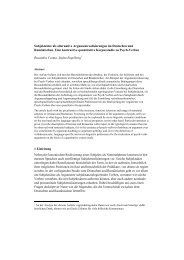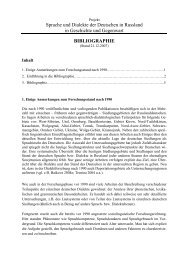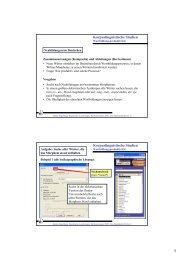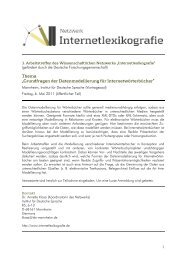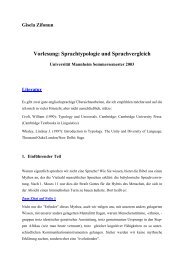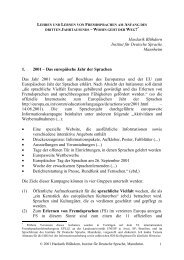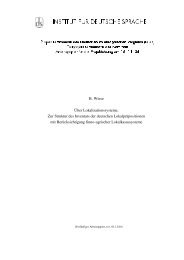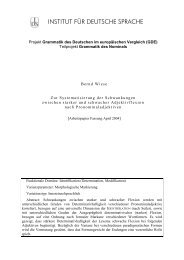Subordination and coordination in syntax, semantics and discourse ...
Subordination and coordination in syntax, semantics and discourse ...
Subordination and coordination in syntax, semantics and discourse ...
You also want an ePaper? Increase the reach of your titles
YUMPU automatically turns print PDFs into web optimized ePapers that Google loves.
Hardarik Blühdorn144). One of the syntactic consequences of semantic symmetry is the possibilityof <strong>in</strong>vert<strong>in</strong>g the sequence of the relata without a significant change of mean<strong>in</strong>g.The relata <strong>in</strong> the follow<strong>in</strong>g example are symmetrically connected. They can be<strong>in</strong>verted without semantic consequences:(14a) Die P<strong>in</strong>gu<strong>in</strong>e waren braun-gelb und die Giraffen waren schwarz-weiß.[the pengu<strong>in</strong>s were yellow-brown, <strong>and</strong> the giraffes were black <strong>and</strong> white](14b) Die Giraffen waren schwarz-weiß und die P<strong>in</strong>gu<strong>in</strong>e waren braun-gelb.[the giraffes were black <strong>and</strong> white, <strong>and</strong> the pengu<strong>in</strong>s were yellow-brown]Hierarchical semantic connections, <strong>in</strong> contrast, are asymmetric. Chang<strong>in</strong>g thesyntactic sequence of their relata will significantly change the mean<strong>in</strong>g. Wherean <strong>in</strong>version of the relata gives rise to such a change of mean<strong>in</strong>g, it can beconcluded that the connection is not understood as symmetrical, even if it issyntactically encoded by a coord<strong>in</strong>ator:(15a) Maria g<strong>in</strong>g <strong>in</strong> die Bibliothek und sie bekam Hunger.[Mary went to the library, <strong>and</strong> she began to feel hungry](15b) Maria bekam Hunger und sie g<strong>in</strong>g <strong>in</strong> die Bibliothek.[Mary began to feel hungry, <strong>and</strong> she went to the library ]In the most plausible read<strong>in</strong>g of these examples, the connected events areordered <strong>in</strong> a temporal sequence, which is <strong>in</strong>verted from (15a) to (15b). It is notuncommon for syntactically coord<strong>in</strong>ative connections to be <strong>in</strong>terpreted <strong>in</strong>semantically asymmetric ways – an effect that can be expla<strong>in</strong>ed by very generalcognitive <strong>and</strong> pragmatic pr<strong>in</strong>ciples (see Grice 1981: 185f; Posner 1980: 182ff;Lang 1984: 80ff; Bre<strong>in</strong>dl 2007a). The examples show that syntactic <strong>coord<strong>in</strong>ation</strong><strong>and</strong> semantic symmetry must be carefully dist<strong>in</strong>guished. By no means can theybe identified with each other.The relata of asymmetric connections cannot be <strong>in</strong>verted without significantsemantic consequences. They have different relational (thematic) roles. One ofthem is be<strong>in</strong>g connected (like a ship that drops its anchor), the other is what it isbe<strong>in</strong>g connected to (like the sea ground <strong>in</strong> which the anchor is fixed). In RonaldLangacker’s (1987: 231ff) term<strong>in</strong>ology, the former is called trajector (T) <strong>and</strong> thelatter l<strong>and</strong>mark (L).Three types of asymmetric connections can be dist<strong>in</strong>guished (see Blühdorn2003: 19f; Blühdorn 2005: 315f):14© 2007 Hardarik Blühdorn, Institut für Deutsche Sprache, Mannheim.


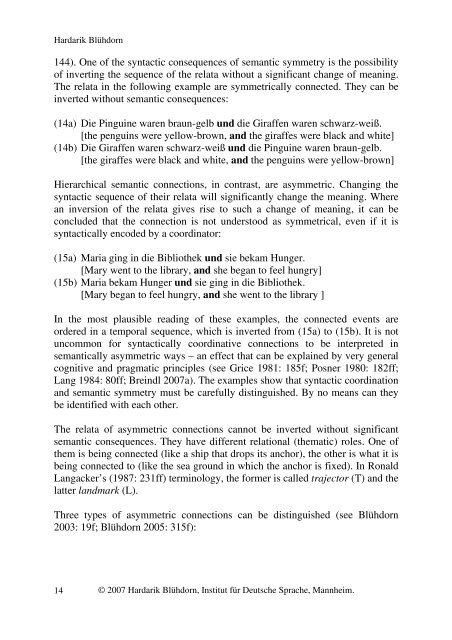
![Ãœbersetzungen-19[1]. - Institut für Deutsche Sprache](https://img.yumpu.com/51701205/1/184x260/aoebersetzungen-191-institut-fur-deutsche-sprache.jpg?quality=85)


